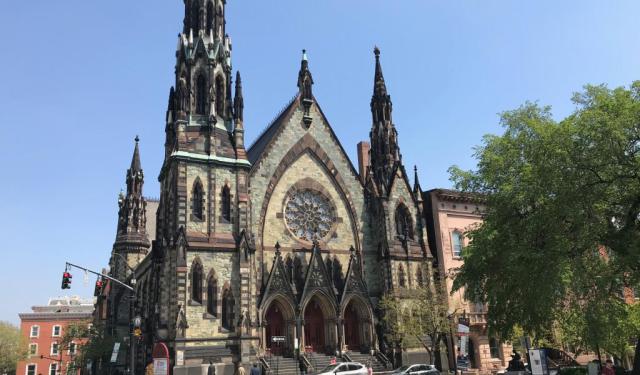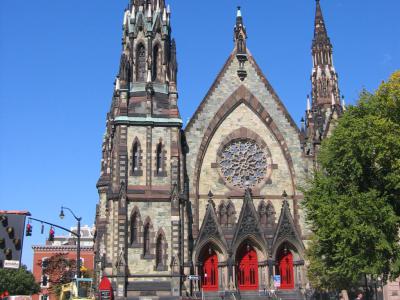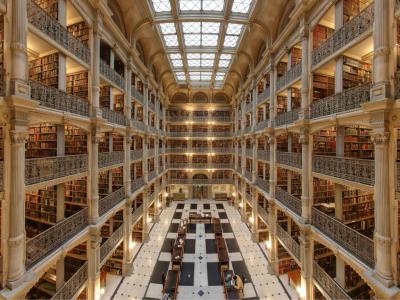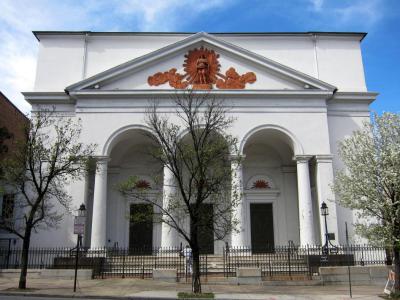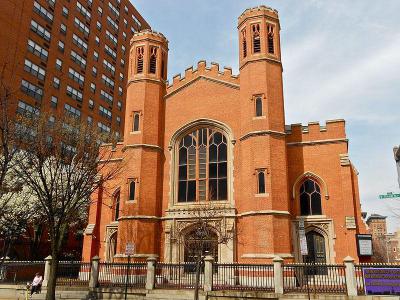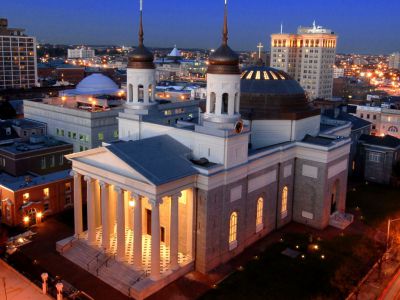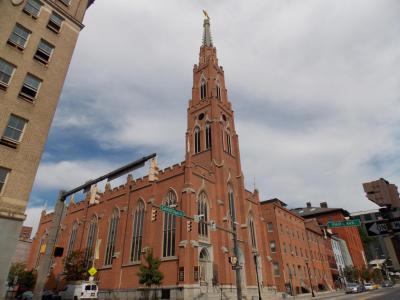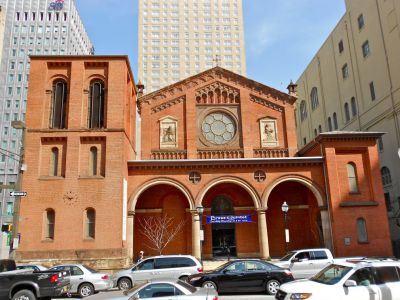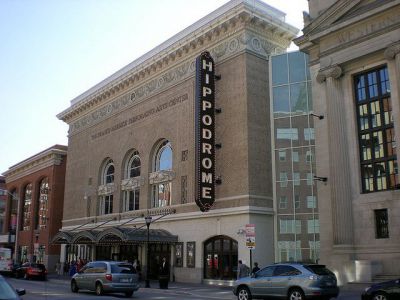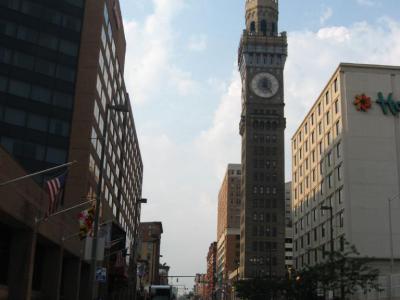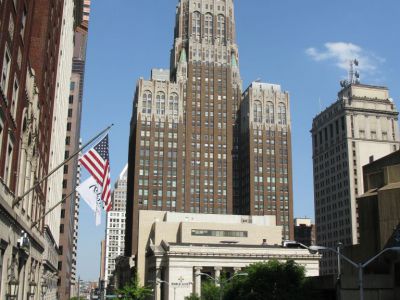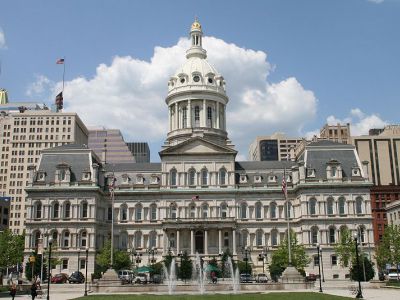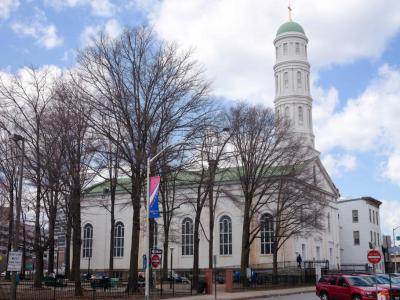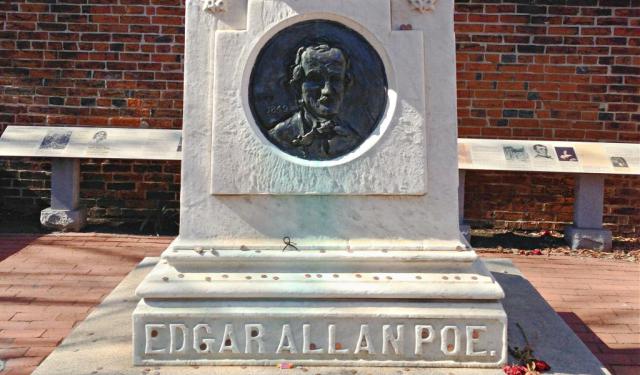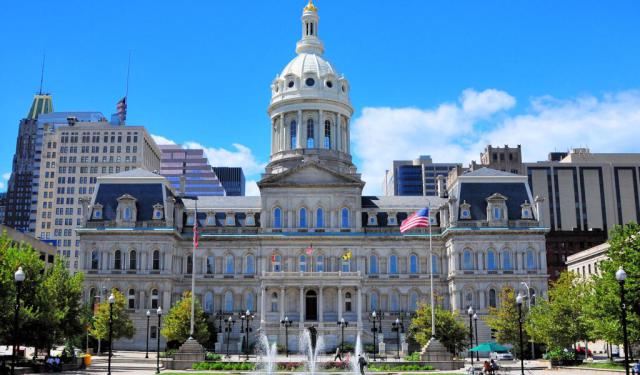Baltimore's Architectural Jewels (Self Guided), Baltimore
Overall, Baltimore's architecture is a testament to the city's rich and varied history, showcasing a wide range of styles and cultural influences that have shaped the local built environment over the centuries. Outside Federal-style row houses and grand Beaux-Arts museums, Baltimore is also known for a multitude of Art Deco buildings and temples of various styles, constructed between the mid-19th and early 20th centuries.
Among them is the First Unitarian Church, one of the finest examples of Federal architecture in the city. Other historic sanctuaries like the St Alphonsus Church (renowned for its beautiful stained-glass windows), Old St Paul's Church (with its signature red brick exterior), and Mt. Vernon Place United Methodist Church (with its stunning bell tower) are the fine pieces of Gothic Revival in the United States.
Also, in the Downtown area, you will find the Basilica of the Assumption, whose dome and columns bear a striking resemblance to the Roman Pantheon. Another splendid example of neoclassical architecture is the St Vincent De Paul Church, featuring a white marble facade and large columns inspired by ancient Greek temples.
The historic Hippodrome Theater, completed in 1914, represents Beaux-Arts, while the Bank of America skyscraper, one of the tallest buildings in Baltimore, completed in 1929, is an excellent showcase of the Art Deco movement.
Other iconic sites include the George Peabody Library, with its six tiers of cast-iron balconies, and the Emerson Bromo-Seltzer Tower – once a symbol of Baltimore's pharmaceutical industry, and now a cultural icon in its own right. And, of course, you can't miss the Baltimore City Hall featuring the Second Empire (or Renaissance Revival) style, richly adorned with white marble and intricate carvings and sculptures.
These are just a few examples of Baltimore's architectural jewels. There are many more to be found in the city, well worth exploring for anyone interested in its cultural heritage. If you wish to learn more about Baltimore's long and storied past set in stone, take this self-guided walking tour and explore at your own pace and in your good time!
Among them is the First Unitarian Church, one of the finest examples of Federal architecture in the city. Other historic sanctuaries like the St Alphonsus Church (renowned for its beautiful stained-glass windows), Old St Paul's Church (with its signature red brick exterior), and Mt. Vernon Place United Methodist Church (with its stunning bell tower) are the fine pieces of Gothic Revival in the United States.
Also, in the Downtown area, you will find the Basilica of the Assumption, whose dome and columns bear a striking resemblance to the Roman Pantheon. Another splendid example of neoclassical architecture is the St Vincent De Paul Church, featuring a white marble facade and large columns inspired by ancient Greek temples.
The historic Hippodrome Theater, completed in 1914, represents Beaux-Arts, while the Bank of America skyscraper, one of the tallest buildings in Baltimore, completed in 1929, is an excellent showcase of the Art Deco movement.
Other iconic sites include the George Peabody Library, with its six tiers of cast-iron balconies, and the Emerson Bromo-Seltzer Tower – once a symbol of Baltimore's pharmaceutical industry, and now a cultural icon in its own right. And, of course, you can't miss the Baltimore City Hall featuring the Second Empire (or Renaissance Revival) style, richly adorned with white marble and intricate carvings and sculptures.
These are just a few examples of Baltimore's architectural jewels. There are many more to be found in the city, well worth exploring for anyone interested in its cultural heritage. If you wish to learn more about Baltimore's long and storied past set in stone, take this self-guided walking tour and explore at your own pace and in your good time!
How it works: Download the app "GPSmyCity: Walks in 1K+ Cities" from Apple App Store or Google Play Store to your mobile phone or tablet. The app turns your mobile device into a personal tour guide and its built-in GPS navigation functions guide you from one tour stop to next. The app works offline, so no data plan is needed when traveling abroad.
Baltimore's Architectural Jewels Map
Guide Name: Baltimore's Architectural Jewels
Guide Location: USA » Baltimore (See other walking tours in Baltimore)
Guide Type: Self-guided Walking Tour (Sightseeing)
# of Attractions: 12
Tour Duration: 2 Hour(s)
Travel Distance: 3.9 Km or 2.4 Miles
Author: rose
Sight(s) Featured in This Guide:
Guide Location: USA » Baltimore (See other walking tours in Baltimore)
Guide Type: Self-guided Walking Tour (Sightseeing)
# of Attractions: 12
Tour Duration: 2 Hour(s)
Travel Distance: 3.9 Km or 2.4 Miles
Author: rose
Sight(s) Featured in This Guide:
- Mt. Vernon Place United Methodist Church
- George Peabody Library
- First Unitarian Church of Baltimore
- Franklin Street Presbyterian Church and Parsonage
- Basilica of the Assumption
- St. Alphonsus Church
- Old St. Paul's Church
- Hippodrome Theater
- Emerson Bromo-Seltzer Tower
- Bank of America Building
- Baltimore City Hall
- St. Vincent De Paul Church
1) Mt. Vernon Place United Methodist Church
Mount Vernon Place United Methodist Church in Baltimore is a significant historical landmark with impressive architectural design and a rich congregation history. The church, completed in 1872, was designed by Thomas Dixon, a Baltimore architect, in the Norman-Gothic style.
Its striking green serpentine stone, buff, olive and red sandstone, polished granite columns, and carved designs taken from nature make it an architectural masterpiece. The many gothic details of flying buttresses, a tower, and arches are purely aesthetic in function, as the building is constructed over an iron framework. The church's interior is also notable for its iron supporting columns, carved wooden beams, and stained glass cross window over the pulpit.
The congregation of the Mount Vernon Place United Methodist Church has a rich history of providing spiritual and secular services to Baltimore. The group began in a building on Lovely Lane in 1784, and the current church on Mount Vernon Place is the congregation's fourth home.
During World War II, the church provided beds, food, and entertainment to servicemen returning from the front. In the 1970s, the church led efforts to help runaway teenagers and victims of drug abuse, and they began a service organization to engage young Baltimoreans in helping their city.
In 1971, the Mount Vernon Place United Methodist Church and Asbury House were listed on the National Register of Historic Places. The Asbury House, designed by Baltimore architects Niernsee & Neilson, was built around 1850 and became the home of George von Lingen, the German consul in Baltimore in 1893. Von Lingen renovated the second-floor library, which features a ceiling painting and intricate carvings done by German workers.
The Mount Vernon Place United Methodist Church is a remarkable historical and architectural landmark that showcases the rich history of Baltimore and the significant contributions of its citizens.
Its striking green serpentine stone, buff, olive and red sandstone, polished granite columns, and carved designs taken from nature make it an architectural masterpiece. The many gothic details of flying buttresses, a tower, and arches are purely aesthetic in function, as the building is constructed over an iron framework. The church's interior is also notable for its iron supporting columns, carved wooden beams, and stained glass cross window over the pulpit.
The congregation of the Mount Vernon Place United Methodist Church has a rich history of providing spiritual and secular services to Baltimore. The group began in a building on Lovely Lane in 1784, and the current church on Mount Vernon Place is the congregation's fourth home.
During World War II, the church provided beds, food, and entertainment to servicemen returning from the front. In the 1970s, the church led efforts to help runaway teenagers and victims of drug abuse, and they began a service organization to engage young Baltimoreans in helping their city.
In 1971, the Mount Vernon Place United Methodist Church and Asbury House were listed on the National Register of Historic Places. The Asbury House, designed by Baltimore architects Niernsee & Neilson, was built around 1850 and became the home of George von Lingen, the German consul in Baltimore in 1893. Von Lingen renovated the second-floor library, which features a ceiling painting and intricate carvings done by German workers.
The Mount Vernon Place United Methodist Church is a remarkable historical and architectural landmark that showcases the rich history of Baltimore and the significant contributions of its citizens.
2) George Peabody Library
The George Peabody Library is a world-renowned research library recognized for its exceptional beauty and impressive collection. Originally established in 1857 as part of the Peabody Institute of the City of Baltimore, the library was funded by George Peabody, a successful Baltimore merchant and War of 1812 veteran who pledged $300,000 for its construction.
The library was designed by architect Edmund G. Lind and officially opened in the late 1870s as part of the east wing of the Peabody Institute. The structural design of the stack room is particularly noteworthy, featuring five tiers of cast-iron balconies that rise to a skylight 61 feet high.
The result is a stunning visual display of the library's 300,000 volume collection, which focuses on texts from the 19th century and covers a diverse range of topics, including religion, art, architecture, topography, science, geography, exploration, and travel.
Despite its status as a leading center for teaching and research, the George Peabody Library remains open to the public, in keeping with Peabody's original intention to create a library "for the free use of all persons who desire to consult it."
Over the years, the library has changed ownership several times, first being transferred to the City of Baltimore and then to the Enoch Pratt Free Library before ultimately becoming part of The Johns Hopkins University educational system in 1982.
Today, the George Peabody Library continues to be a source of inspiration and wonder for students, researchers, and visitors from around the world. Its stunning architecture and impressive collection of rare and unique texts make it a must-see destination for anyone with an interest in history, literature, or architecture.
The library was designed by architect Edmund G. Lind and officially opened in the late 1870s as part of the east wing of the Peabody Institute. The structural design of the stack room is particularly noteworthy, featuring five tiers of cast-iron balconies that rise to a skylight 61 feet high.
The result is a stunning visual display of the library's 300,000 volume collection, which focuses on texts from the 19th century and covers a diverse range of topics, including religion, art, architecture, topography, science, geography, exploration, and travel.
Despite its status as a leading center for teaching and research, the George Peabody Library remains open to the public, in keeping with Peabody's original intention to create a library "for the free use of all persons who desire to consult it."
Over the years, the library has changed ownership several times, first being transferred to the City of Baltimore and then to the Enoch Pratt Free Library before ultimately becoming part of The Johns Hopkins University educational system in 1982.
Today, the George Peabody Library continues to be a source of inspiration and wonder for students, researchers, and visitors from around the world. Its stunning architecture and impressive collection of rare and unique texts make it a must-see destination for anyone with an interest in history, literature, or architecture.
3) First Unitarian Church of Baltimore
The First Unitarian Church of Baltimore has a rich history dating back to 1817 when it was founded as the “First Independent Church of Baltimore” by a group of free thinkers with “liberal sentiments” on religion. The church was built within two months of its founding, and completed in 1818. It is the oldest purpose-built Unitarian church in North America and a National Historic Landmark.
Designed by French émigré Maximilian Godefroy, the church is considered among the world’s finest examples of French Neoclassical architecture. Its design was daring for the time, using basic shapes of the cube, sphere, and triangle with a minimum of detail.
In 1893, a major interior renovation was undertaken, which added a barrel-vaulted ceiling to improve the sanctuary’s acoustics and a Tiffany mosaic of “The Last Supper” composed of some 65,000 pieces of favrile glass.
The church played an important role in the development of Unitarianism in the United States. At the 1819 ordination of the church’s first minister, Jared Sparks, the Rev. Dr. William Ellery Channing delivered a landmark sermon that defined the tenets of Unitarianism in the United States, emphasizing freedom, reason, and tolerance. Known as the “Baltimore Sermon,” it led to the formation of the denomination in 1825.
Over the years, the First Unitarian Church of Baltimore has had a number of notable members, including artist Rembrandt Peale, George Peabody, Enoch Pratt, pioneering social worker Mary Richmond, and Adelyn Breeskin, the first woman director of the Baltimore Museum of Art.
Today, the church continues to serve as a spiritual and cultural center for its congregation and the community. Its rich history and beautiful architecture make it a must-see destination for anyone interested in the history of religion and architecture in America.
Designed by French émigré Maximilian Godefroy, the church is considered among the world’s finest examples of French Neoclassical architecture. Its design was daring for the time, using basic shapes of the cube, sphere, and triangle with a minimum of detail.
In 1893, a major interior renovation was undertaken, which added a barrel-vaulted ceiling to improve the sanctuary’s acoustics and a Tiffany mosaic of “The Last Supper” composed of some 65,000 pieces of favrile glass.
The church played an important role in the development of Unitarianism in the United States. At the 1819 ordination of the church’s first minister, Jared Sparks, the Rev. Dr. William Ellery Channing delivered a landmark sermon that defined the tenets of Unitarianism in the United States, emphasizing freedom, reason, and tolerance. Known as the “Baltimore Sermon,” it led to the formation of the denomination in 1825.
Over the years, the First Unitarian Church of Baltimore has had a number of notable members, including artist Rembrandt Peale, George Peabody, Enoch Pratt, pioneering social worker Mary Richmond, and Adelyn Breeskin, the first woman director of the Baltimore Museum of Art.
Today, the church continues to serve as a spiritual and cultural center for its congregation and the community. Its rich history and beautiful architecture make it a must-see destination for anyone interested in the history of religion and architecture in America.
4) Franklin Street Presbyterian Church and Parsonage
The Franklin Street Presbyterian Church and Parsonage were built in 1847 and 1857, respectively, and designed by architect Robert Cary Long, Jr in the Tudor Gothic style. The church was incorporated in 1844 by a group of men from the First Presbyterian Church, which was located in downtown Baltimore.
The front of the church features two flanking octagonal towers, each standing at 60 feet tall. The towers are also crenelated and have louvered belfry openings and stained glass Gothic-arched windows.
The manse or parsonage at the north end of the church has similar matching walls of brick, heavy Tudor-Gothic window hoods, and battlements atop the roof. The church is located on "Cathedral Hill," in the southern part of the community, bordering downtown Baltimore to the south and across the street from the old Baltimore Cathedral (Basilica of the National Shrine of the Assumption of the Blessed Virgin Mary), erected 1806-1821, and designed by Benjamin Latrobe, which was the first Catholic cathedral constructed in America.
In 1973, the First and Franklin Street Presbyterian Church was formed by two historic downtown area congregations, and the Franklin Street building was used by the merged congregation for a time.
Later, the building was sold to a fundamentalist independent Protestant congregation and was later re-sold to the present "New Unity Church Ministries." The church is no longer used by a Presbyterian congregation and is currently occupied by the New Unity Church Ministries / New Unity Baptist Church, with Pastor Johnny N. Golden, sr.
The church and manse / parsonage in the rear were listed on the National Register of Historic Places on November 5, 1971. They are included within the Cathedral Hill Historic District and the Baltimore National Heritage Area and in the Mount Vernon-Belvedere neighborhood.
The front of the church features two flanking octagonal towers, each standing at 60 feet tall. The towers are also crenelated and have louvered belfry openings and stained glass Gothic-arched windows.
The manse or parsonage at the north end of the church has similar matching walls of brick, heavy Tudor-Gothic window hoods, and battlements atop the roof. The church is located on "Cathedral Hill," in the southern part of the community, bordering downtown Baltimore to the south and across the street from the old Baltimore Cathedral (Basilica of the National Shrine of the Assumption of the Blessed Virgin Mary), erected 1806-1821, and designed by Benjamin Latrobe, which was the first Catholic cathedral constructed in America.
In 1973, the First and Franklin Street Presbyterian Church was formed by two historic downtown area congregations, and the Franklin Street building was used by the merged congregation for a time.
Later, the building was sold to a fundamentalist independent Protestant congregation and was later re-sold to the present "New Unity Church Ministries." The church is no longer used by a Presbyterian congregation and is currently occupied by the New Unity Church Ministries / New Unity Baptist Church, with Pastor Johnny N. Golden, sr.
The church and manse / parsonage in the rear were listed on the National Register of Historic Places on November 5, 1971. They are included within the Cathedral Hill Historic District and the Baltimore National Heritage Area and in the Mount Vernon-Belvedere neighborhood.
5) Basilica of the Assumption
The Basilica of the Assumption, referred to as the Baltimore Basilica, is a Roman Catholic Church. It was the first Roman Catholic cathedral built in the United States and was among the first religious buildings constructed after the adoption of the U.S. Constitution. It was consecrated on May 31, 1821.
Construction on the Baltimore Basilica began in 1806. Architect Benjamin Henry Latrobe, known as "the Father of American Architecture," designed the building in the Neoclassical style with guidance from John Carroll, the first American bishop of the Roman Catholic church.
The cathedral is noted for its onion-shaped dome. The interior has many works of fine art, including two that were gifted to the basilica by King Louis XVIII of France.
The Basilica of the Assumption is on the U.S. National Register of Historic Places and is considered a U.S. National Historic Landmark.
Construction on the Baltimore Basilica began in 1806. Architect Benjamin Henry Latrobe, known as "the Father of American Architecture," designed the building in the Neoclassical style with guidance from John Carroll, the first American bishop of the Roman Catholic church.
The cathedral is noted for its onion-shaped dome. The interior has many works of fine art, including two that were gifted to the basilica by King Louis XVIII of France.
The Basilica of the Assumption is on the U.S. National Register of Historic Places and is considered a U.S. National Historic Landmark.
6) St. Alphonsus Church
Saint Alphonsus Church is a historic Roman Catholic church complex located in the Archdiocese of Baltimore, Maryland, United States. The complex consists of the church, rectory, convent, and halle, and is also known as Saint John Neumann Shrine and "Baltimore's Powerhouse of Prayer." The church complex was constructed between 1842 and 1845 based on the design of Saint Stephen's Cathedral in Vienna and follows a basilica floorplan. The structure is constructed of red brick with limestone accents in the Gothic Revival style.
The nave of Saint Alphonsus Church reaches a height of 50 ft (15 m), and the ornate steeple rises 210 ft (64 m) above the three-level bell tower. A 12 ft (3.7 m) gold cross caps the steeple, making it a prominent landmark in the area. The church was the first major design by Baltimore architect Robert Cary Long Jr.
From its founding until 1917, the parish was overseen by the Redemptorist Fathers, who came to Baltimore to minister to the growing German immigrant community. John Neumann, who later became Bishop of Philadelphia, was one of the early pastors of Saint Alphonsus. Neumann's assistant pastor, Francis Xavier Seelos, served as pastor after his departure and later worked in areas from Connecticut to Illinois and New Orleans. Both Neumann and Seelos have been canonized and beatified, respectively.
By 1917, many of the German immigrants who lived in the area moved elsewhere, and Saint Alphonsus became a parish for the Lithuanian immigrant community. The church complex was listed on the National Register of Historic Places in 1973.
Since 1992, Saint Alphonsus has held regular Tridentine Masses. Since 2017, the parish has been administered by the Priestly Fraternity of Saint Peter (FSSP), while remaining officially part of the Archdiocese of Baltimore. Saint Alphonsus Church remains a significant landmark in the area, and its history is an important part of the city's cultural heritage.
The nave of Saint Alphonsus Church reaches a height of 50 ft (15 m), and the ornate steeple rises 210 ft (64 m) above the three-level bell tower. A 12 ft (3.7 m) gold cross caps the steeple, making it a prominent landmark in the area. The church was the first major design by Baltimore architect Robert Cary Long Jr.
From its founding until 1917, the parish was overseen by the Redemptorist Fathers, who came to Baltimore to minister to the growing German immigrant community. John Neumann, who later became Bishop of Philadelphia, was one of the early pastors of Saint Alphonsus. Neumann's assistant pastor, Francis Xavier Seelos, served as pastor after his departure and later worked in areas from Connecticut to Illinois and New Orleans. Both Neumann and Seelos have been canonized and beatified, respectively.
By 1917, many of the German immigrants who lived in the area moved elsewhere, and Saint Alphonsus became a parish for the Lithuanian immigrant community. The church complex was listed on the National Register of Historic Places in 1973.
Since 1992, Saint Alphonsus has held regular Tridentine Masses. Since 2017, the parish has been administered by the Priestly Fraternity of Saint Peter (FSSP), while remaining officially part of the Archdiocese of Baltimore. Saint Alphonsus Church remains a significant landmark in the area, and its history is an important part of the city's cultural heritage.
7) Old St. Paul's Church
Old Saint Paul's Church, also known as Saint Paul's Protestant Episcopal Church, is a historic Episcopal church. The church was founded in 1692 as the parish church for the "Patapsco Parish," which was one of the original 30 parishes of the Church of England in colonial Maryland. Today, it is part of the Episcopal Church, U.S.A. and the Anglican Communion.
The present church building was designed by the renowned architect Richard Upjohn, who is best known for his Gothic Revival style. However, the design of Old Saint Paul's Church features an eclectic mix of architectural elements. The exterior facade, for example, combines 12th-century Italian elements with Romanesque elements on the interior.
One of the most notable features of the exterior facade is the two bas-reliefs of Christ and Moses, which were executed by the Italian sculptor Antonio Capellano. These bas-reliefs were originally part of the facade of the previous Robert Cary Long church.
Other elements from the 1817 structure include the walls of the Federal period building, a stained glass window of the risen Christ over the entrance, a marble baptismal font designed by Maximilian Godefroy, and the Bishop's chair given to Saint Paul's in 1815.
Old Saint Paul's Church has had many prominent members throughout its history, including Samuel Chase, John Eager Howard, Thomas Johnson, and William Donald Schaefer, who served as mayor of Baltimore and governor and comptroller of Maryland.
In recognition of its historical significance, Saint Paul's Protestant Episcopal Church was listed on the National Register of Historic Places in 1973. It is also included within the Cathedral Hill Historic District and the Baltimore National Heritage Area.
The present church building was designed by the renowned architect Richard Upjohn, who is best known for his Gothic Revival style. However, the design of Old Saint Paul's Church features an eclectic mix of architectural elements. The exterior facade, for example, combines 12th-century Italian elements with Romanesque elements on the interior.
One of the most notable features of the exterior facade is the two bas-reliefs of Christ and Moses, which were executed by the Italian sculptor Antonio Capellano. These bas-reliefs were originally part of the facade of the previous Robert Cary Long church.
Other elements from the 1817 structure include the walls of the Federal period building, a stained glass window of the risen Christ over the entrance, a marble baptismal font designed by Maximilian Godefroy, and the Bishop's chair given to Saint Paul's in 1815.
Old Saint Paul's Church has had many prominent members throughout its history, including Samuel Chase, John Eager Howard, Thomas Johnson, and William Donald Schaefer, who served as mayor of Baltimore and governor and comptroller of Maryland.
In recognition of its historical significance, Saint Paul's Protestant Episcopal Church was listed on the National Register of Historic Places in 1973. It is also included within the Cathedral Hill Historic District and the Baltimore National Heritage Area.
8) Hippodrome Theater
The Hippodrome Theatre in Baltimore, Maryland, is a historic vaudeville theater that opened in 1914. The theater was designed by Thomas Lamb, a renowned theater architect of the time, and had a capacity of 2300 seats. It was originally built as a movie theater and vaudeville house, and it boasted a Moller organ and a house orchestra that played until the 1950s.
The Hippodrome Theatre was a major attraction in Baltimore, and by 1920, it hosted 30,000 attendees a week. Some of the biggest stars in the entertainment industry graced its stage, including Bob Hope, Jack Benny, Red Skelton, Benny Goodman, Dinah Shore, Martha Raye, Milton Berle, the Andrews Sisters, and Morey Amsterdam. The Hippodrome Theatre was also where Frank Sinatra first appeared with the Tommy Dorsey Orchestra in 1939.
After several decades of declining business, the Hippodrome Theatre closed its doors in 1990 as the last movie theater in downtown Baltimore. However, in 2004, the theater was reopened as part of the France-Merrick Performing Arts Center, which also saved two other important historic buildings in the area, the Western National Bank and the Eutaw Savings Bank.
Since its reopening in 2004, the Hippodrome Theatre has become the city's premier venue for touring Broadway productions and other high-quality live performances. Some of the blockbuster musicals that have graced its stage include Wicked, The Lion King, Les Misérables, Hairspray, and Cats. The theater is the heart of the Bromo Tower Arts and Entertainment District, which is part of a plan to revitalize the West side of downtown Baltimore and its vicinity.
The Hippodrome Theatre's history and recent renovation make it a significant cultural landmark in Baltimore, and it continues to attract audiences with its world-class performances and stunning architecture.
The Hippodrome Theatre was a major attraction in Baltimore, and by 1920, it hosted 30,000 attendees a week. Some of the biggest stars in the entertainment industry graced its stage, including Bob Hope, Jack Benny, Red Skelton, Benny Goodman, Dinah Shore, Martha Raye, Milton Berle, the Andrews Sisters, and Morey Amsterdam. The Hippodrome Theatre was also where Frank Sinatra first appeared with the Tommy Dorsey Orchestra in 1939.
After several decades of declining business, the Hippodrome Theatre closed its doors in 1990 as the last movie theater in downtown Baltimore. However, in 2004, the theater was reopened as part of the France-Merrick Performing Arts Center, which also saved two other important historic buildings in the area, the Western National Bank and the Eutaw Savings Bank.
Since its reopening in 2004, the Hippodrome Theatre has become the city's premier venue for touring Broadway productions and other high-quality live performances. Some of the blockbuster musicals that have graced its stage include Wicked, The Lion King, Les Misérables, Hairspray, and Cats. The theater is the heart of the Bromo Tower Arts and Entertainment District, which is part of a plan to revitalize the West side of downtown Baltimore and its vicinity.
The Hippodrome Theatre's history and recent renovation make it a significant cultural landmark in Baltimore, and it continues to attract audiences with its world-class performances and stunning architecture.
9) Emerson Bromo-Seltzer Tower
The Emerson Bromo-Seltzer Tower, standing at 15 stories high and 88 meters tall, is an iconic skyscraper in downtown Baltimore. Built in 1911, the tower was designed by architect Joseph Evans Sperry for Isaac E. Emerson, the inventor of Bromo-Seltzer, a popular headache remedy at the time. The tower was the tallest building in Baltimore from its construction in 1911 until 1923, and its design was inspired by the Palazzo Vecchio in Florence, Italy, which Emerson saw during a tour of Europe in 1900.
The tower features four clock faces on its 15th floor, each measuring 24 feet in diameter, with the letters "B-R-O-M-O S-E-L-T-Z-E-R" in translucent white glass, and the Roman numerals being less prominent. Originally powered by weights, the clocks are now electrically powered and are illuminated at night by mercury-vapor lamps. The minute and hour hands of the clocks are 12 and 10 feet in length, respectively.
The tower was originally topped by a 51-foot Bromo-Seltzer bottle, which rotated and glowed blue, with 314 incandescent light bulbs, and a crown. However, due to structural concerns, it was removed in 1936. Despite this, the tower remains a Baltimore landmark and is listed on the National Register of Historic Places.
After an extensive renovation, the Bromo Seltzer Arts Tower was opened in 2008 and now houses studio spaces for visual and literary artists. The tower also features the still-functioning tower clock, the largest four-dial gravity-driven non-chiming clock in the world, designed by Seth Thomas in 1911. The clock underwent a full restoration in 2017.
The Emerson Bromo-Seltzer Tower is a historic and impressive structure that has stood the test of time and remains an important part of Baltimore's skyline and cultural heritage.
The tower features four clock faces on its 15th floor, each measuring 24 feet in diameter, with the letters "B-R-O-M-O S-E-L-T-Z-E-R" in translucent white glass, and the Roman numerals being less prominent. Originally powered by weights, the clocks are now electrically powered and are illuminated at night by mercury-vapor lamps. The minute and hour hands of the clocks are 12 and 10 feet in length, respectively.
The tower was originally topped by a 51-foot Bromo-Seltzer bottle, which rotated and glowed blue, with 314 incandescent light bulbs, and a crown. However, due to structural concerns, it was removed in 1936. Despite this, the tower remains a Baltimore landmark and is listed on the National Register of Historic Places.
After an extensive renovation, the Bromo Seltzer Arts Tower was opened in 2008 and now houses studio spaces for visual and literary artists. The tower also features the still-functioning tower clock, the largest four-dial gravity-driven non-chiming clock in the world, designed by Seth Thomas in 1911. The clock underwent a full restoration in 2017.
The Emerson Bromo-Seltzer Tower is a historic and impressive structure that has stood the test of time and remains an important part of Baltimore's skyline and cultural heritage.
10) Bank of America Building
The Bank of America Building, formerly known as the Baltimore Trust Company Building, is a stunning 34-story skyscraper located in the heart of downtown Baltimore. It was designed by the architectural firm of Taylor and Fisher and completed in just eighteen months at a cost of $3 million in 1929.
When it was first built, the Bank of America Building was the tallest building in the state and the tallest office building south of New York City. The building's exterior is an impressive sight, decorated with ornate Romanesque human and animal images, stylized eagles, and intricate carvings of birds and lions. The copper and gold roof on top of the building is a sight to behold and adds to its grandeur.
The building's interior is equally impressive, featuring a two-story main banking lobby that is highly decorated with mosaic floors designed by Hildreth Meiere. The lobby also showcases historic murals by Griffith Baily Coale and McGill Mackall that depict significant events in Baltimore's history, such as the Baltimore fire of 1904 and the writing of the National Anthem during the War of 1812.
Despite its grandeur and historical significance, the building faced financial troubles shortly after its completion. The Baltimore Trust Company, which moved into the building in 1929, went bankrupt in 1933 and was placed in receivership in 1935. The building remained vacant until the Public Works Administration in Maryland took it over as part of the New Deal.
Today, the Bank of America Building remains a landmark and a testament to the city's rich history and architectural legacy. Plans to cover the historic lobby's mosaic floors with artificial turf to create an Under Armour gym have been met with controversy, but the building's stunning exterior and ornate interior continue to attract visitors from all over the world.
When it was first built, the Bank of America Building was the tallest building in the state and the tallest office building south of New York City. The building's exterior is an impressive sight, decorated with ornate Romanesque human and animal images, stylized eagles, and intricate carvings of birds and lions. The copper and gold roof on top of the building is a sight to behold and adds to its grandeur.
The building's interior is equally impressive, featuring a two-story main banking lobby that is highly decorated with mosaic floors designed by Hildreth Meiere. The lobby also showcases historic murals by Griffith Baily Coale and McGill Mackall that depict significant events in Baltimore's history, such as the Baltimore fire of 1904 and the writing of the National Anthem during the War of 1812.
Despite its grandeur and historical significance, the building faced financial troubles shortly after its completion. The Baltimore Trust Company, which moved into the building in 1929, went bankrupt in 1933 and was placed in receivership in 1935. The building remained vacant until the Public Works Administration in Maryland took it over as part of the New Deal.
Today, the Bank of America Building remains a landmark and a testament to the city's rich history and architectural legacy. Plans to cover the historic lobby's mosaic floors with artificial turf to create an Under Armour gym have been met with controversy, but the building's stunning exterior and ornate interior continue to attract visitors from all over the world.
11) Baltimore City Hall
Baltimore City Hall is the seat of government for Baltimore. It houses the offices of the Mayor, the city council, and other government officials.
The building was designed by a 22-year-old architect, George A. Frederick, in the Second Empire architectural style. The engineer Wendel Bollman designed the city hall's dome and cast iron roof. Construction began in 1867 and was completed in 1875.
The six-story edifice was the first building constructed solely for the city's government. Before its construction, city leaders met in the Maryland Insurance Company building, the Baltimore Dancing Assembly, the Baltimore Exchange Company, and Peale's Baltimore Museum and Gallery of Fine Arts.
The City Hall fell under disrepair after the end of World War II. After 15 pounds of iron collapsed from the iron dome into the Board of Estimates hearing room, a decision was made to renovate the building. Two additional floors were added, which doubled the usable space in the building.
Baltimore City Hall is designated as a Baltimore City Landmark; is on the U.S. National Register of Historic Places.
The building was designed by a 22-year-old architect, George A. Frederick, in the Second Empire architectural style. The engineer Wendel Bollman designed the city hall's dome and cast iron roof. Construction began in 1867 and was completed in 1875.
The six-story edifice was the first building constructed solely for the city's government. Before its construction, city leaders met in the Maryland Insurance Company building, the Baltimore Dancing Assembly, the Baltimore Exchange Company, and Peale's Baltimore Museum and Gallery of Fine Arts.
The City Hall fell under disrepair after the end of World War II. After 15 pounds of iron collapsed from the iron dome into the Board of Estimates hearing room, a decision was made to renovate the building. Two additional floors were added, which doubled the usable space in the building.
Baltimore City Hall is designated as a Baltimore City Landmark; is on the U.S. National Register of Historic Places.
12) St. Vincent De Paul Church
Saint Vincent de Paul Church is the oldest Catholic parish church in continuous use in Baltimore, having been dedicated in 1841. The church has a rich history that is intertwined with the city's history.
The church was founded by Irish workers who were building the Baltimore and Ohio Railroad and the Chesapeake and Ohio Canal. It was built to serve the ever-increasing, wealthy, English-speaking Catholics in the Gay and Pratt Street area. Saint Vincent de Paul Church welcomed people of all social ranks, including slaves and free people of color. In fact, the church had a slave gallery, which was removed during a 1890s restoration.
In 1875, the church was consecrated by Archbishop James Gibbons, one of four churches so recognized in America, which placed it under the direct protection of the Holy See. The parish's most famous son was James Cardinal Gibbons, who was born and raised in the church.
Over its 178-year life, the church has undergone several renovations, including a comprehensive interior renovation in 1991, which was completed in time for the 150th anniversary of construction. However, the exterior of the church has never been altered. The church building is neoclassical style, with brick walls painted white to give it the appearance of wood. Inside there are cast iron columns for support.
The church features a slender Georgian-style brick tower, painted white, which rises to a height of 150 feet above the narthex. The tower rests on an octagonal base and supports three successive indented tiers, capped by a copper-sheathed dome and twelve-foot gold-leafed cross. The church building features pediments and lintels quarried from Jones Falls stone. The tower serves as an iconic image for the historic Jonestown neighborhood of Baltimore and is visually paired with the nearby red brick historic Phoenix Shot Tower.
Throughout its long and diverse history, Saint Vincent de Paul Church has maintained its original structure and is still an active and engaged parish today. The church and its members are very proud of the wide variety of backgrounds and cultures that have accumulated over the years.
The church was founded by Irish workers who were building the Baltimore and Ohio Railroad and the Chesapeake and Ohio Canal. It was built to serve the ever-increasing, wealthy, English-speaking Catholics in the Gay and Pratt Street area. Saint Vincent de Paul Church welcomed people of all social ranks, including slaves and free people of color. In fact, the church had a slave gallery, which was removed during a 1890s restoration.
In 1875, the church was consecrated by Archbishop James Gibbons, one of four churches so recognized in America, which placed it under the direct protection of the Holy See. The parish's most famous son was James Cardinal Gibbons, who was born and raised in the church.
Over its 178-year life, the church has undergone several renovations, including a comprehensive interior renovation in 1991, which was completed in time for the 150th anniversary of construction. However, the exterior of the church has never been altered. The church building is neoclassical style, with brick walls painted white to give it the appearance of wood. Inside there are cast iron columns for support.
The church features a slender Georgian-style brick tower, painted white, which rises to a height of 150 feet above the narthex. The tower rests on an octagonal base and supports three successive indented tiers, capped by a copper-sheathed dome and twelve-foot gold-leafed cross. The church building features pediments and lintels quarried from Jones Falls stone. The tower serves as an iconic image for the historic Jonestown neighborhood of Baltimore and is visually paired with the nearby red brick historic Phoenix Shot Tower.
Throughout its long and diverse history, Saint Vincent de Paul Church has maintained its original structure and is still an active and engaged parish today. The church and its members are very proud of the wide variety of backgrounds and cultures that have accumulated over the years.
Walking Tours in Baltimore, Maryland
Create Your Own Walk in Baltimore
Creating your own self-guided walk in Baltimore is easy and fun. Choose the city attractions that you want to see and a walk route map will be created just for you. You can even set your hotel as the start point of the walk.
Edgar Allan Poe’s Baltimore
Edgar Allan Poe was a great American writer of short stories and poems. His works, from "The Raven" to "The Tell-Tale Heart," have inspired generations. Devotees of Edgar Allan Poe will find many mesmerizing spots in Edgar Allan Poe's Baltimore.
Poe moved to Baltimore for the first time in 1829 and left shortly thereafter. He returned in 1831 and wrote many poems and... view more
Tour Duration: 2 Hour(s)
Travel Distance: 5.5 Km or 3.4 Miles
Poe moved to Baltimore for the first time in 1829 and left shortly thereafter. He returned in 1831 and wrote many poems and... view more
Tour Duration: 2 Hour(s)
Travel Distance: 5.5 Km or 3.4 Miles
Baltimore Introduction Walking Tour
Baltimore is the largest city in Maryland. It is part of the Washington-Baltimore combined metropolitan area, making it a popular spot for those visitors who wish to see the city of Baltimore and the nation's capital. The city has a rich history in the founding of the United States.
Pre-colonization, the land that Baltimore now lies upon was inhabited by Paleo-Indians dating as far back as... view more
Tour Duration: 2 Hour(s)
Travel Distance: 3.6 Km or 2.2 Miles
Pre-colonization, the land that Baltimore now lies upon was inhabited by Paleo-Indians dating as far back as... view more
Tour Duration: 2 Hour(s)
Travel Distance: 3.6 Km or 2.2 Miles
The Most Popular Cities
/ view all
